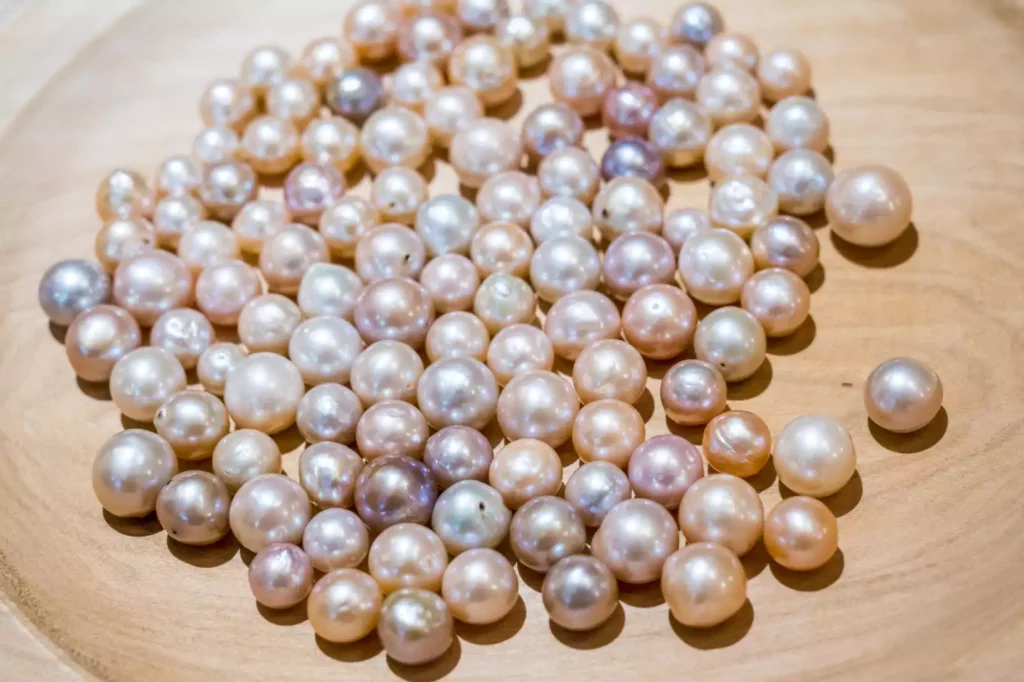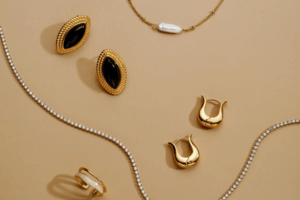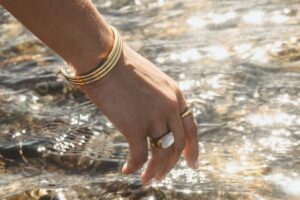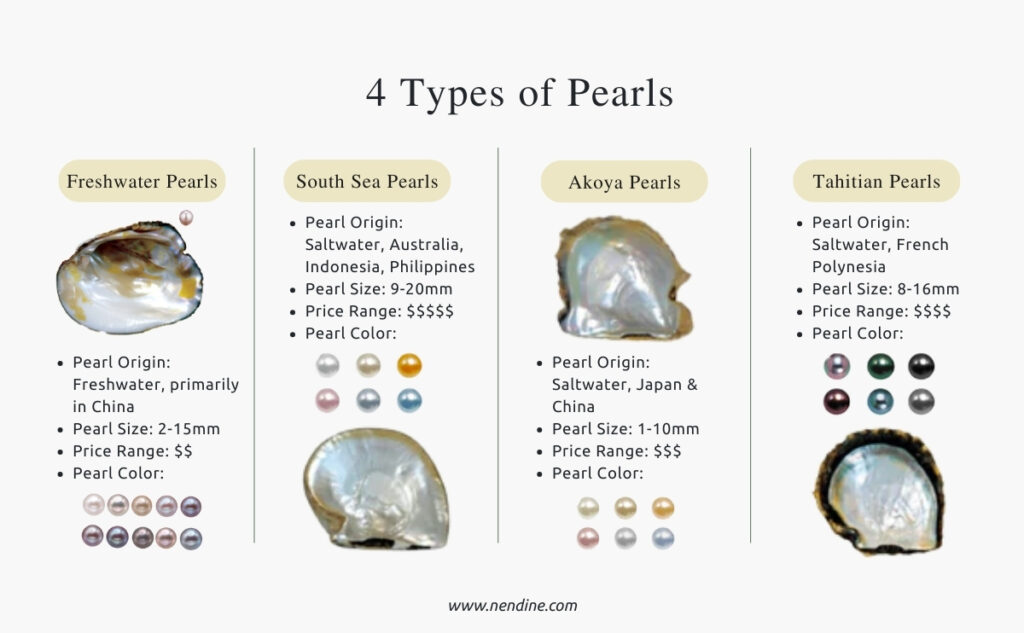
Pearls are lustrous, organic gems formed inside mollusks like oysters and mussels. When an irritant enters the shell, the mollusk secretes layers of nacre—also known as mother-of-pearl—creating a pearl over time. Both freshwater and saltwater mollusks can produce pearls naturally or through cultivation. Depending on their origin, pearls vary in composition, luster, size, and value.
In this guide, we’ll explore types of pearls, highlighting key differences such as freshwater vs saltwater pearls, cultured vs natural pearls, and pearl composition to help you better understand these timeless gems.
Natural Pearls
Natural pearls are formed entirely by nature—without any human intervention. When an irritant accidentally enters a pearl-producing mollusk, such as an oyster, mussel, or abalone, the mollusk protects itself by coating the intruder with layers of nacre, the same substance that gives pearls their luster. This process takes years and happens without any artificial nucleus or stimulation.
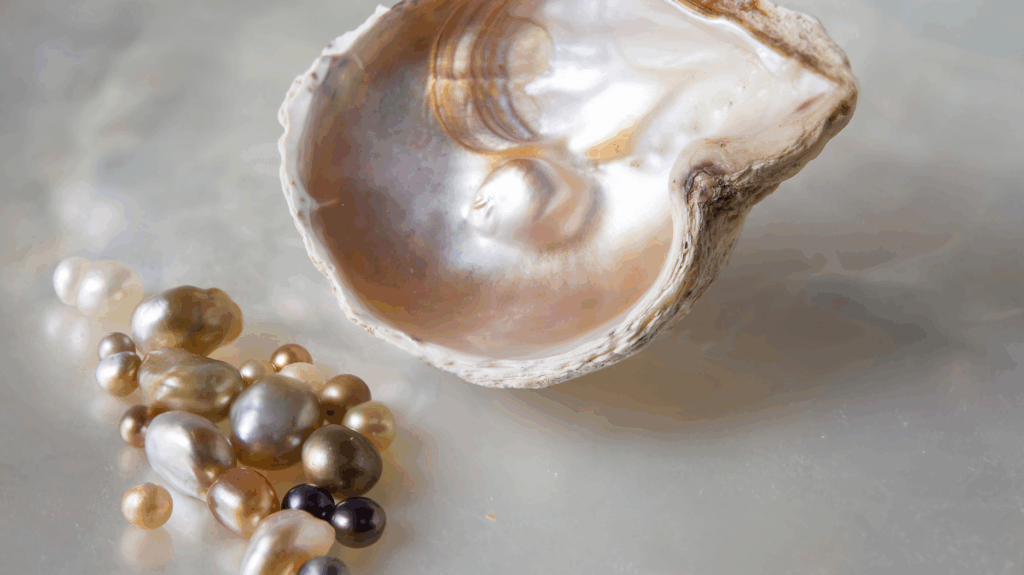
Source: Google
Natural pearls, formed without human intervention, are incredibly rare today. Pearls can be grouped into two types based on where they are found: freshwater pearls and saltwater pearls.
- Natural Freshwater Pearls: formed in mussels in rivers, lakes, and ponds. Though more accessible and slightly more common than their saltwater counterparts, they are still very rare.
- Natural Saltwater Pearls: formed inside wild saltwater oysters in oceans and seas. Due to overharvesting, pollution, and restrictions on open-sea diving, they are now extremely rare.
Cultured Pearls
Cultured pearls are pearls produced through a human-induced process. The process of pearl formation is quite slow. Thus, through a process called “pearl cultivation,” pearl farmers surgically insert an irritant into a shell bead nucleus inside the soft tissue of the oyster. From there, the layers of nacre are formed naturally in response to the irritant, just like with natural pearls.
This raises an important question: are cultured pearls real pearls? The answer is yes. Cultured pearls are genuine pearls made of the same nacre as natural ones, but the process is initiated by humans.
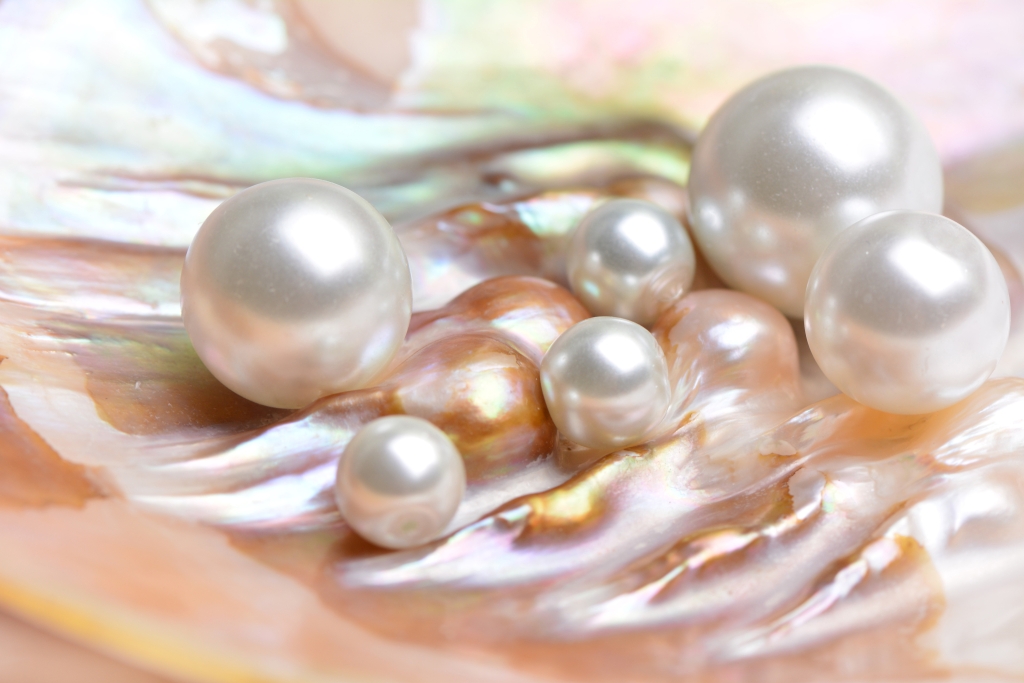
Source: Google
1. Properties
Cultured pearls are generally classified into four groups depending on their origin. These include freshwater pearls, akoya, Tahitian, white, and golden South Sea Pearls. These pearls are unique based on the parts of the world in which they are cultivated and the type of mollusk used in their cultivation. However, there are a few general properties of cultured pearls. Some of these properties are listed below:
2. Texture
Cultured pearls generally possess a smooth, slightly gritty texture due to their nacreous layers.
3. Luster
Unlike most gemstones and precious metals, pearl luster is more than just a reflection on the surface. Luster, which is often described by synonyms like sheen, glitter, sparkle, or brightness, appears to come from within the pearl. The greater the intensity, the higher the brilliance. A pearl’s luster is said to be pearly iridescent.
4. Hardness
Pearls have a Mohs hardness value ranging from 2.5 to 4.5, indicating that they are fragile and easily scratched or damaged if not properly cared for.
5. Chemical composition
All pearls have essentially the same chemical composition. This includes calcium carbonate (CaCO3), organic substances, and water.
6. Refractive index
The refractive index, also known as the index of refraction, is a measurement of the bending or refraction of a light ray as it passes from one medium to another. The refractive index of pearls is about 1.53 on average.
7. Specific gravity
The specific gravity or relative density of pearls ranges from 2.65 to 2.78. This is a result of the variable composition of the pearls.
8. Color and appearance
The color and appearance of pearls vary based on the species of mollusk from which they are obtained. Pearls can be white, pink, silver, cream, gold, green, blue, ivory, black, pale yellow, gray, or brown in color.
Based on the amount of light they permit to pass through them, pearls vary progressively from translucent to opaque.
9. Common sizes and shapes
The sizes and shapes of cultured pearls are linked to their types. Thus, we will be examining them based on their types.
Natural Pearls vs Cultured Pearls
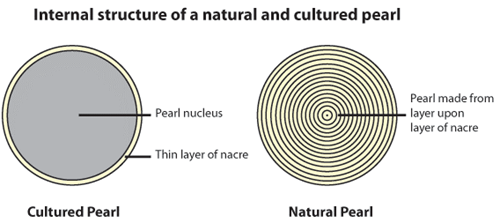
Source: Google
Natural pearls and cultured pearls may look similar to the naked eye, but their formation, availability, and value differ significantly. Here’s a quick comparison:
| Feature | Natural Pearls | Cultured Pearls |
| Formation | Formed entirely by nature without human intervention | Formed by manually inserting an irritant into the mollusk |
| Occurrence | Extremely rare in the wild | Widely produced on pearl farms |
| Nacre Thickness | Typically thicker, since formation happens over many years | May have thinner nacre depending on farming practices |
| Availability | Very limited and often antique | Readily available in the market |
| Price | Extremely expensive due to rarity | More affordable and available in various grades |
| Investment Value | High collectible and antique value | Moderate, depending on quality and origin |
Freshwater Pearls vs Saltwater Pearls
Cultured Pearls include freshwater and saltwater pearls, which differ in their source mollusks, appearance, and market value. Here’s how they compare:
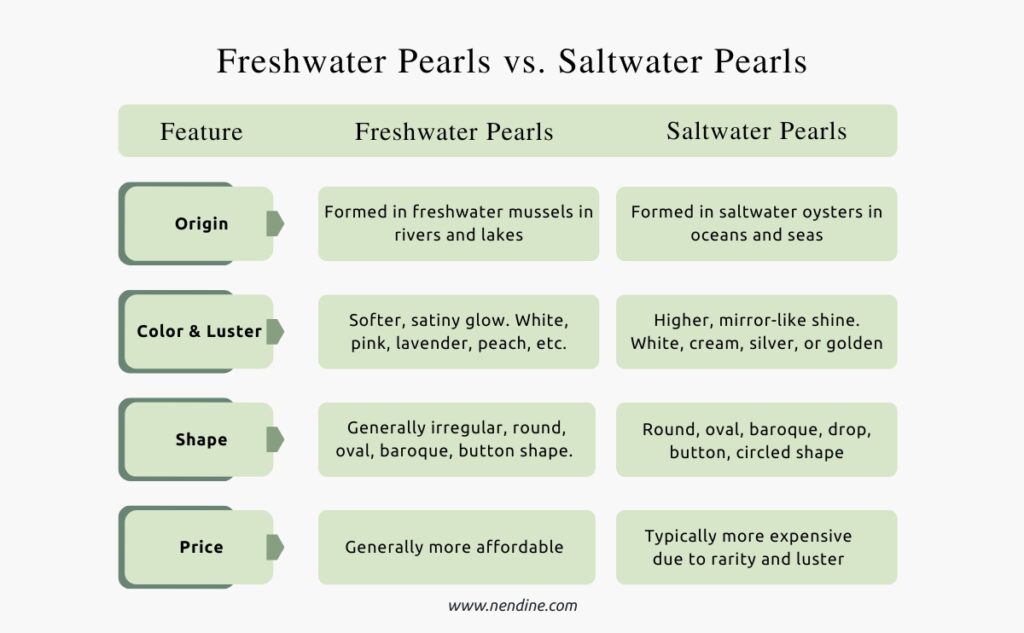
1. Origin
Freshwater pearls are produced by mussels in lakes and rivers, while saltwater pearls are formed in oysters found in oceans and seas.
2. Color
Freshwater pearls come in a wider variety of natural pastel shades (white, peach, lavender). On the other hand, saltwater pearls are typically white, cream, or golden with overtones like pink, green, or silver.
3. Luster
Freshwater pearls tend to have a softer, more satiny glow, while saltwater pearls generally have a higher luster and mirror-like shine.
4. Shape
Human intervention leads to freshwater pearls forming around natural tissue, resulting in a more irregular shape. In contrast, saltwater pearls develop around a spherical bead, consistently yielding a smooth, round finish.
5. Price
Freshwater pearls are more affordable due to higher supply and simpler farming. On the other hand, saltwater pearls are typically more expensive due to longer cultivation and lower yield.
Freshwater Pearls
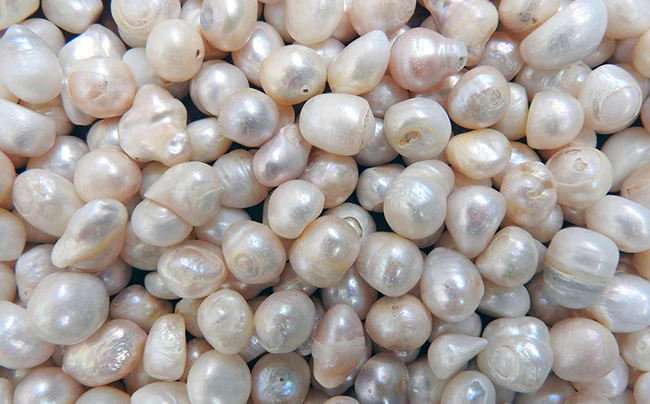
Source: Google
- Size: Freshwater pearls come in a wide range of sizes. They can grow up to 20 mm in size, making them the world’s largest cultured pearls alongside South Sea pearls. They are, nevertheless, the cheapest and most common type. Typical sizes found in the market include 7mm to 12mm pearls.
- Shape: Due to the manufacturing process, freshwater pearls are rarely precisely spherical. They are generally irregular (baroque-shaped). Common shapes include a coin shape, button shape, stick shape, drop shape, off-round (near-round) shape, and very rarely, a circular shape.
Akoya Pearls
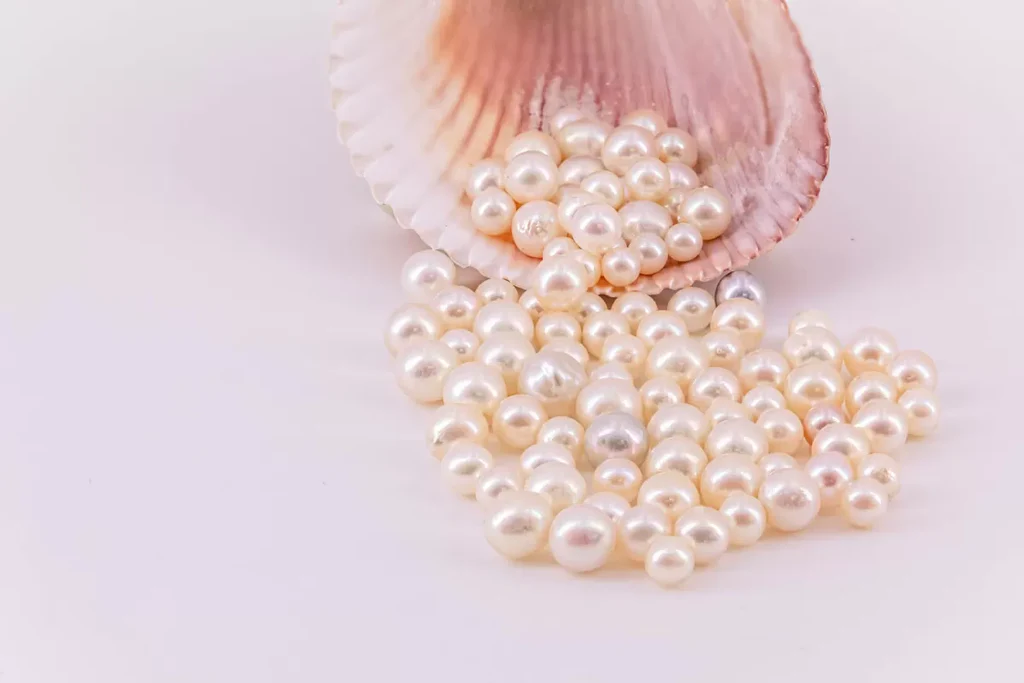
Source: Google
- Size: One of the tiniest varieties of cultured pearls, Akoya pearls, range in size from as little as 1.0mm seed-like pearls up to 9.0mm, and very rarely, growing up to 10.0mm. The most common and popular sizes range from 6.0 mm to 6.5 mm to 9.0 mm to 9.5 mm.
- Shape: Because of their smaller sizes, Akoya pearls are not as varied in size as other types of pearls. Common shape of Akoya pearls include round, near-round, drop or pear-shaped and baroque.
Tahitian Pearls

Source: Google
- Size: Tahitian pearls are significantly larger than Akoya pearls. They range in size from medium to enormous pearls. Tahitian pearls range in size from 8 to 18mm. However, the most prevalent sizes on the market range from 9 to 15mm.
- Shape: Due to their larger size, Tahitian pearls offer a wild variety of options for you to choose from. Typical shape of Tahitian pearls include round, semi-round, pear-shaped, baroque, buttom, oval, and circled shape.
South Sea Pearls
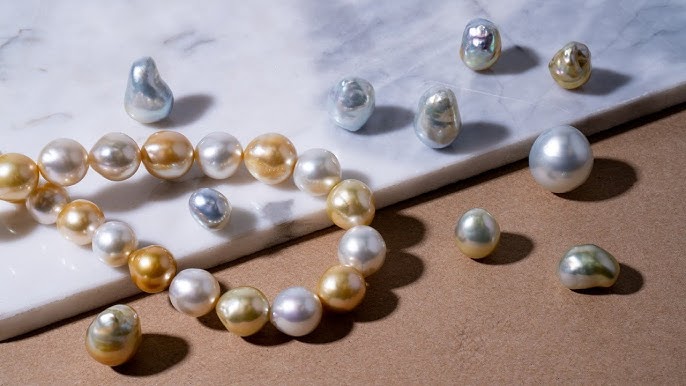
Source: Google
- Size: Along with freshwater pearls, south sea pearls are the largest type of cultured pearls in the market today. However, on average, they are usually larger than freshwater pearls, ranging in size from 8.0 mm to 20.0 mm, with an average size falling between 12.0 and 15.0 mm.
- Shape: South Sea pearls come in a variety of shape, such as round, semi-round, baroque, button, oval, and ringed. The rarest of them being the rounded one.
How Much Are Pearls Worth? Pricing Pearl Prices Chart
Certain factors influence the price of pearls. These factors include nacre, luster, size, shape, color, texture, and rarity. The two most important factors are size and shape; the larger a pearl is, the more expensive it is. When it comes to shape, due to their rarity, perfectly rounded pearls are usually more expensive.
Having said all that, the prices of pearls follow this pattern:
Freshwater pearls < Akoya pearls < Tahitian pearls < South Sea pearls (< means “less than”)
For a deeper breakdown, you can also explore our detailed pearl price list by pearl color – from the most to least expensive to understand how different pearl colors impact value.
| Pearl Type | Estimated Price Range (USD) | Notes |
| Freshwater Pearls | $75 – $5,000 | Affordable and widely available; prices vary by size, shape, and luster. |
| Akoya Pearls | $500 – $10,000 | Known for round shape and mirror-like luster; mostly from Japan. |
| Tahitian Pearls | $2,000 – $25,000 | Naturally dark pearls with unique overtones; grown in French Polynesia. |
| South Sea Pearls | $3,000 – $100,000 | Largest and most valuable pearls; white or golden, very rare. |
How to Choose the Type of Pearls?
When selecting pearls for your jewelry line, two key factors should guide your decision: budget and design preferences.
Budget
Pearl costs vary significantly. Freshwater pearls are the most affordable, ideal for accessible lines. If your budget is limited, shell pearls are also a great alternative. Akoya pearls offer a mid-range option, while Tahitian, South Sea, and Sea of Cortez pearls are premium choices for luxury brands that prioritize exclusivity and premium quality.
Aesthetic Preferences
Each pearl type has a distinct look. Freshwater pearls come in diverse colors and irregular shapes. Akoya pearls are known for classic white and roundness. Tahitian pearls offer exotic dark hues, and South Sea pearls boast large white and golden tones. Match the pearl’s aesthetic to your brand’s design vision—whether it’s classic, contemporary, or artistic.
Key Takeaway
Pearls are the only gemstones of organic origin—formed by living mollusks rather than mined from the earth. Treasured for generations, their natural elegance and soft iridescence give them a timeless appeal that never fades.
Whether you’re choosing freshwater pearls or saltwater pearls, you’re investing in a gem with enduring charm, sophistication, and versatility. To explore a wide range of pearls suited for both modern and classic designs, visit Nendine.
